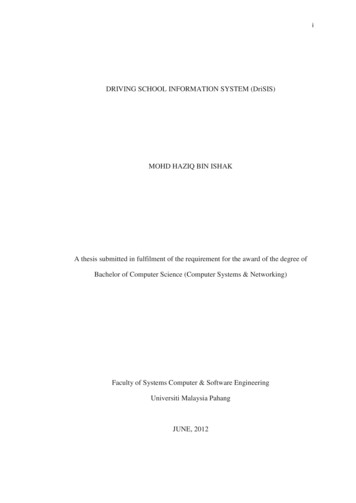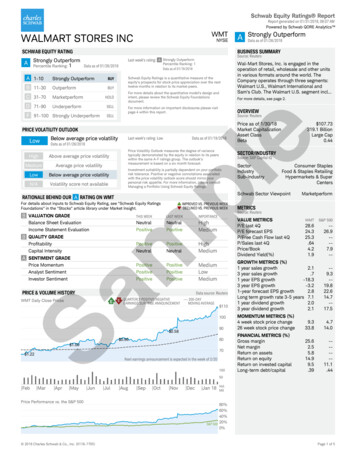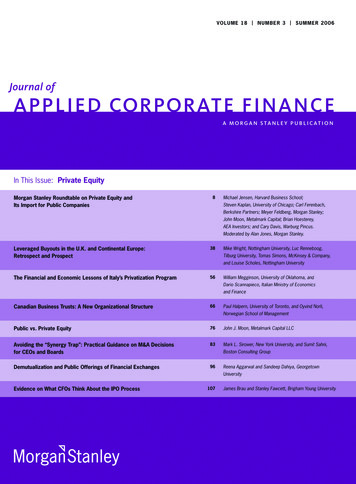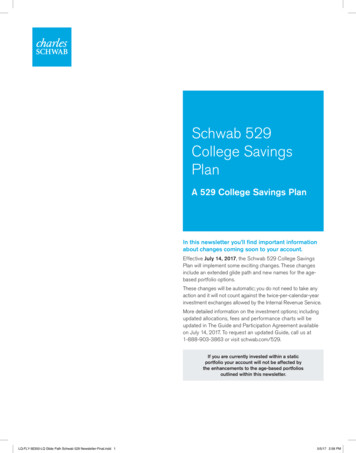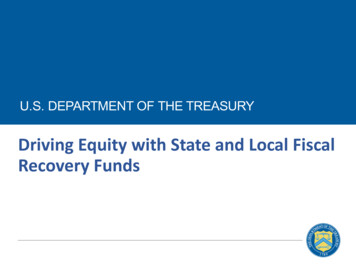
Transcription
Driving Equity with State and Local FiscalRecovery Funds
2Economic recovery from the pandemic is a top priority for theBiden-Harris Administration and the Treasury Department. Across the country, a strong economic recovery is taking hold, but concertedwork is still needed to ensure that recovery is swift, equitable, andsustainable. The pandemic also laid bare the need for rapid, highly-effectiveimplementation of relief programs. Reflecting the urgency of this work, Treasury created the new Office ofRecovery Programs to: Implement recovery programs as expeditiously, effectively, and equitably aspossible; Ensure a coordinated, cohesive approach – both within Treasury and withour partner agencies – to implementing these programs and supporting therecovery; and Provide accountability and transparency for outcomes in these programs.
3An “Ambitious” Mandate“Our country faces converging economic, health, and climate crises that haveexposed and exacerbated inequities, while a historic movement for justice hashighlighted the unbearable human costs of systemic racism. Our Nation deservesan ambitious whole-of-government equity agenda that matches the scale of theopportunities and challenges that we face.” –President BidenThree key principles should ground agency activities pursuant to EO 13985: Advancing equity must be a core part of management and policy makingprocesses. Successful equity work yields tangible changes that positively impact Americanlives. Equity benefits not just some of us, but all Americans.
4Coronavirus State and Local Fiscal RecoveryFunds OverviewThe American Rescue Plan Act of 2021 created the Coronavirus State and LocalFiscal Recovery Funds (SLFRF) program to deliver 350 billion for state, territories,municipalities, counties, and Tribal governments much needed aid.The key objectives for SLFRF are to: Support the urgent COVID-19 response efforts to continue to decrease spreadof the virus and bring the pandemic under control; Replace lost revenue for eligible recipients to strengthen support for vitalpublic services and help retain jobs; Support an equitable recovery through immediate economic stabilization forhouseholds and businesses; and Address systemic public health and economic challenges that have contributedto the inequal impact of the pandemic on certain populations.
5State and Local Fiscal Recovery:Reporting GuidanceThe Reporting Guidance addresses priority areas to ensure a speedy and equitable recovery.Equity FocusedCommunityEmpoweringWorkerCenteredResults andevidencefocusedDetailed information on reporting requirements and deadlines is available at:www.treasury.gov/SLFRP
6Activity for Participants Think about the highest impact service you provide. How do you know if those services are reaching theintended beneficiaries and those most in need? Who else could you talk to/engage to learn more thanyou know now?
7Panel Discussion Kim Leary: Senior Equity Fellow, White House Office ofManagement and Budget (Moderator) Veronica Briseno: Chief Economic Recovery Officer, Cityof Austin Ashleigh Gardere: Executive Vice President, PolicyLink Leila Al-Hamoodah: Operations Advisor, ColoradoGovernor’s Office
8Leading with Equity in Austin’sEconomic Recovery Programs
9Starting with Equity“Equity is the condition when every member of the community has a fair opportunity to live a long, healthy, andmeaningful life. Equity embedded into Austin’s values system means changing hearts and minds, transforminglocal government from the inside out, eradicating disparities, and ensuring all Austin community membersshare in the benefits of community progress.” - Austin Strategic Direction 2023 The Austin City Council adopted a resolution in 2015directing the City Manager to evaluate the impact ofexisting city policies and practices on racial equity anddevelop an Equity Assessment Tool that can be usedacross City departments during the budget process. Austin established an Equity Office in 2016 to focus onadvancing equity in all aspects of City operations. Thefirst Chief Equity Officer began this work in October2016. Austin’s Chief Equity Officer is part of the City’s COVID19 Economic Recovery Core Directors Team.
10Economic Recovery Program Impact Distributed 115M through 13 programs since April 2020 Served over 204,580 households and 1,640 businesses Assisted thousands of Austinites through additionalsupportive services and programs:– Austin Civilian Conservation Corps– Austin Mental Wellness Support Line– Healthcare Access Program– No-Cost Business Coaching– Deferred City Property Tenant Payments– Utility Disconnection Moratorium
11Equitable Program Administration Strategies Translated applications to several languages including Spanish,Chinese, Arabic, and Vietnamese.Partnered with local multi-ethnic Chambers of Commerce(Austin Asian, Austin Hispanic, Austin Black and Austin Gay &Lesbian Chambers of Commerce) to inform local businessesabout relief opportunities.Funded community-based organizations to advertise reliefprograms and help locals apply for relief opportunities.Published application questions and documentationrequirements several days before grants opened - ensuringapplicants had time to prepare materials.Promoted grant programs via community-specific media outlets(e.g., Univision).Partnered with the City of Austin's Equity Office to ensureguidelines did not disproportionately disadvantage businessowners of color.
12Examples of Equity-Oriented Program GuidelinesThe Austin Live Music Venue Preservation Fundrequired applicants to attend three racial equityworkshops and create an Equity Strategic Planbefore receiving grants up to 40,000 a month for sixmonths (not to exceed 140,000).The Austin Non-Profit Relief Grant and the AustinSmall Business Relief Grant scored applicants using amatrix that included criteria for need, vulnerability,and equity.The Austin Childcare Provider Relief Grant awardedadditional grant funds to childcare operators locatedin historically marginalized communities.The Austin Mental Wellness Support Line providedmental health counseling in English, Spanish, andover 150 other languages.
13Economic Recovery Program DashboardsLaunched several interactive dashboards, available atATXrecovers.com: Austin Childcare Provider Relief GrantAustin Creative Space Disaster Relief ProgramAustin Economic Injury Bridge Loan ProgramAustin Music Disaster Relief FundAustin Non-Profit Relief GrantAustin Small Business Relief GrantTypes of information includes: Number of applicantsApplicant profilesApplicant City Council districtsApproval/denial ratesIndustry sectorsAnd much more
14Diverse Economic Recovery Focus Groups Convened diverse focus groups to inform City of Austin’seconomic recovery and resiliency efforts:– Personal services (e.g., salons/barbers, cleaners, etc.)– Manufacturing– Experience (e.g., festivals, hospitality, nightlife, etc.)– Creative (e.g., arts, media, entertainment, etc.)– Food/Restaurants– Cross-Sector (e.g., workers rights, chambers, etc.) The focus groups identified 45 opportunities to foster a moreequitable, competitive, and resilient post-pandemic economy.
15Driving Equity Through DataState of Colorado
16Build BackStrongerListening Tour
17Data and Evidence in State GovernmentThe State Measurement for Accountable,Responsive, and Transparent (SMART)Government Act requires us to: Establish a performancemanagement system for managingstate agencies Incorporate continuous processimprovement Ensure state employees are trained inperformance management and processimprovement17LINK to Colorado Performance Management Guidelines
18Using an Equity, Diversity, and Inclusion LensPerformance management should advance equity, diversity, andinclusion.When developing your performance goals, ask yourself: Could this goal proposal unintentionally burden traditionally underserved ordisadvantaged communities? How will this goal proposal benefit traditionally underserved or disadvantagedcommunities? What would the impacted communities say about your goal and its strategies, and arethey able to provide feedback without language, accessibility, or technologicalbarriers? Do the impacted communities have the means to hold my agency accountable? What additional data will I collect to make sure my activities are benefitting a broadrange of Coloradans and/or serving particular populations of interest?
19Identifying Stimulus Metrics
2010 Priorities for Advancing Racial EquityThrough the American Rescue Plan ActA Guide for City and County Policymakers
21A Guide for City and County Policymakers10 Priorities for Advancing Racial Equity Through the American Rescue Plan ActDeveloped in partnership withcommunity leaders, chief equityofficers, policymakers, economicdevelopment practitioners, researchand policy organizations, andphilanthropic partners, the reportsuggests municipal strategies fordeploying ARPA funds equitably,efficiently, and ember 31, 2021
22A Guide for City and County PolicymakersAmerican Rescue Plan Act – Equity WorksheetThe guide lays out a framework for equitable decision-making around ARPA spending and investments withprompts that local leaders can use to not only ask hard questions around racial equity, but also seek to addressthem.December 31, 2021
Q&A
24More InformationTo Explore Austin’s Equity Tool:http://austintexas.gov/department/equityTo Explore Colorado’s Listening Tour:https://www.buildbackstrongerco.com/For More Information on Colorado’sPerformance Management 1AkWJx3BAD0NPxfPHzkJq8ZEaS3voMah9NfojI0/editTo Explore PolicyLink’s Equity Tools ools/american-rescue-plan-10-prioritiesFor More Information on Treasury COVID-19Economic Relief & Recovery ronavirusTo Request State & Local Fiscal RecoveryFunds:Please visit www.treasury.gov/SLFRPFor General Inquiries on State & Local FiscalRecovery Funds:Please email SLFRP@treasury.gov
develop an Equity Assessment Tool that can be used across City departments during the budget process. Austin established an Equity Office in 2016 to focus on advancing equity in all aspects of City operations. The first Chief Equity Officer began this work in October 2016. Austin's Chief Equity Officer is part of the City's COVID-
